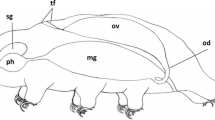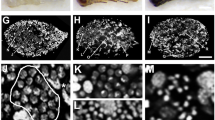Abstract
Bdelloids reproduce via obligate apomictic parthenogenesis. Oogenesis occurs through two subsequent equational divisions, with the extrusion of two polar bodies. Although the morphology of the bdelloid reproductive apparatus has been previously described, the eutely of the germarium has never been investigated. We studied oogenesis in Macrotrachela quadricornifera by assessing: (1) the constancy of oocyte number, (2) chromosome number and size, and (3) the DNA content of oocytes and blastomeres. Oocyte number at birth is constant and determines maximal fertility. We found a chromosome number of 5, in which two homologous pairs can be recognized. The genome size of the species is 0.75 picograms.
Similar content being viewed by others
References
Amsellem, J. & C. Ricci, 1982. Fine structure of the female genital apparatus of Philodina (Rotifera, Bdelloidea). Zoomorphology 100: 89–105.
Bentfeld, M. E., 1971a. Studies of oogenesis in the rotifer Asplanchna. I. Fine structure of the female reproductive system. Z. Zellforsh. 115: 165–183.
Bentfeld, M. E., 1971b. Studies of oogenesis in the rotifer Asplanchna. II. Oocyte growth and development. Z. Zellforsh. 115: 184–195.
Clément, P., 1980. Phylogenetic relationships of rotifers, as derived from photoreceptor morphology and other ultrastructural analyses. In H. J. Dumont & J. Green (eds), Rotatoria. Developments in Hydrobiolgy I. Dr W. Junk Publishers, The Hague: 93–117. Reprinted from Hydrobiologia 73.
Gilbert, J. J., 1983. Rotifera. In K. G. Adiyodi & Adiyodi R. G. (eds), Reproductive biology of invertebrates. Volume I: Oogenesis, oviposition, and oosorption. J. Wiley & sons, Chichester.: 181–209.
Hsu, W. S., 1956a. Oogenesis in the Bdelloidea rotifer Philodina roseola. La Cellule 57: 283–296.
Hsu, W. S., 1956b. Oogenesis in Habrotrocha tridens. Biol. Bull. 111: 364–374.
Huebner, E. & E. Anderson, 1976. Comparative spiralian oogenesis. Structural aspects: an overview. Am. Zool. 16: 315–343.
Jones, P. A. & J. J. Gilbert, 1976. Male haploidy in rotifers: relative DNA content of nuclei from male and female Asplanchna. J. exp. Zool. 198: 281–285.
Jones, P. A. & J. J. Gilbert, 1977. Polymorphism and polyploidy in the rotifer Asplanchna sieboldi: relative DNA contents in tissues of saccate and campanulate females. J. exp. Zool. 201: 163–168.
Maynard Smith, J., 1986. Contemplating life without sex. Nature 324: 300–301.
Pagani, M., C. Ricci & A. M. Bolzern, 1991. Comparison of five strains of a parthenogenetic species, Macrotrachela quadricornifera (Rotifera, Bdelloidea). II. Isoenzymatic patterns. Hydrobiologia 211: 157–163.
Pellicciari, C., S. Garagna, D. Formenti, C. A. Redi, M. G. Manfredi Romanini & M. Benazzi, 1986. Feulgen-DNA amounts and karyotype lengths of three planarian species of the genus Dugesia. Experientia 42: 75–77.
Plasota, K. & M. Plasota, 1980. The determination of the chromosome number of Habrotrocha rosa Donner, 1949. In H. J. Dumont & J. Green (eds), Rotatoria. Developments in Hydrobiolgy I. Dr W. Junk Publishers, The Hague: 43–44. Reprinted from Hydrobiologia 73.
Ricci, C., 1987. Ecology of bdelloids: how to be successful. In L. May, R. Wallace & A. Herzig (eds), Rotifer Symposium IV. Developments in Hydrobiology 42. Dr W. Junk Publishers, The Hague: 117–127. Reprinted from Hydrobiologia 147.
Ricci, C., 1991. Comparison of five strains of a parthenogenetic species, Macrotrachela quadricornifera (Rotifera, Bdelloidea). I. Life history traits. Hydrobiologia 211: 147–155.
Ricci, C., M. Pagani & A. M. Bolzern, 1989. Temporal analysis of clonal structure in a moss bdelloid population. In C. Ricci, T. W. Snell & C. E. King (eds), Rotifer Symposium V. Kluwer Academic Publishers, Dordrecht: 145–152. Reprinted from Hydrobiologia 186/187.
Rishi, K. K., A. K. Datta Gupta & J. Kamal, 1983. On the chromosomes of a monogonont rotifer, Asplanchna brightwelli (Gosse). Chromosome Information Service 35: 5–6.
Robotti, C., 1975. Chromosome complement and male haploidy of Asplanchna priodonta Gosse 1850 (Rotatoria). Experientia 37: 1270–1271.
Sparrow, A. H., H. J. Price & A. G. Underbrink, 1972. A survey of DNA content per cell and per chromosome of prokariotic and eukariotic organisms: some evolutionary considerations. In: H. H. Smith (ed.), Evolution of genetic systems, Brookhaven Symposia in Biology, nr. 23. Gordon & Breach, New York: 451–494.
Storch, O., 1924. Die Eizellen der heterogon Radertiere. Zool. Jb. 2, 45: 309–404.
Tauson, A. O., 1924. Die reifungsprozesse der parthenogenetischen eier von Asplanchna intermedia Huds. Z. Zellforsch. 1: 57–84.
Tauson, A. O., 1927. Die spermatogenese bei Asplanchna intermedia Huds. Z. Zellforsch. 4: 652–681.
Whitney, D. D., 1929. The chromosome cycle in the rotifer Asplanchna amphora. J. Morphol. Physiol. 47: 415–433.
Author information
Authors and Affiliations
Rights and permissions
About this article
Cite this article
Pagani, M., Ricci, C. & Redi, C.A. Oogenesis in Macrotrachela quadricornifera (Rotifera, Bdelloidea). Hydrobiologia 255, 225–230 (1993). https://doi.org/10.1007/BF00025843
Issue Date:
DOI: https://doi.org/10.1007/BF00025843




